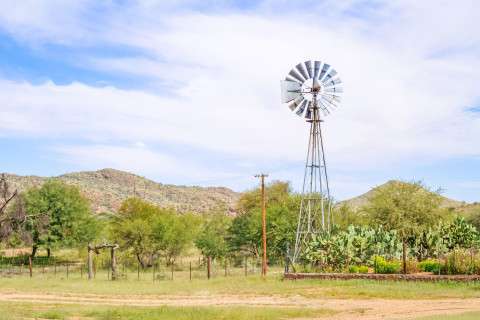The doctoral dissertation in the field of Forestry will be examined at the Faculty of Science, Forestry and Technology, Joensuu Campus and online.
What is the topic of your doctoral research? Why is it important to study the topic?
The topic of my doctoral research is “Wildlife activity patterns and encroaching woody vegetation response to bush thinning on farmlands in north-central Namibia”. It is important to study the topic since the Namibian savannah biome has experienced anthropogenic pressures, resulting in the disruption of key ecological processes. Consequently, a dense and thorny woody vegetation structure known bush encroachment, has proliferated in landscapes that were historically sparsely vegetated. Livestock farming and wildlife conservation are key sectors of the national economy.
In recent decades, significant loss of grazing capacity as well as suitable habitat for some wildlife has been experienced. To counteract some of the negative effects associated with this phenomenon, restoration thinning that involves the selective reduction of excess woody biomass has been applied as a recommended strategy. Studies of this nature would increase knowledge regarding the responses of ecological components towards treatment effects, to maintain ecological integrity and sustainable management of natural resources.
What are the key findings or observations of your doctoral research?
This thesis demonstrated that bush encroachment can be controlled by thinning excess woody densities. Thinned areas had greater wildlife activity than non-thinned areas, possibly due to favourable habitat conditions resulting from the reduction of woody vegetation densities which promoted ease to manoeuvre, better grass cover and longer sighting lines to detect distant prey or predators. Natural regeneration of woody species was rapid in thinned areas.
Also, woody species responded differently towards the thinning treatment (reduced abundance for the umbrella thorn and increase of the umbrella thorn). Large predators were the most responsive to the thinning treatment and would increase their activity in thinned areas. On a typical farm, bush control is done to increase grazing for livestock. A higher activity of predators in these areas could potentially place a risk to unprotected livestock and increase human wildlife conflict.
Therefore, appropriate mitigation strategies should be developed in areas targeted for restoration thinning efforts. Although it is feasible to control bush encroachment, varied responses observed amongst encroaching woody species suggests that thinning could potentially alter the ecological structure and local distribution of species as preferred species are reduced, and low-density species are promoted.
How can the results of your doctoral research be utilised in practice?
Results of the wildlife research can be used to influence the development of effective predator conflict mitigation strategies to reduce potential risks for human-wildlife conflict, predation risks to prey species, and modelling habitat suitability for different species to accommodate habitat requirements for wildlife.
Results of the vegetation surveys have practical implications towards the management of bush encroached and restored areas and can be used to directly influence the development of protocols for sustainable biomass harvesting to prevent overharvesting of certain species and minimise the loss of soil nutrients as well as post thinning management plans to prevent rapid re-encroachment; influence the assessments of wildlife habitats to model suitability, species-treatment interactions to identify current conditions and project future population trends and ecosystem dynamics.
What are the key research methods and materials used in your doctoral research?
Wildlife surveys were carried out using remotely triggered camera traps in randomised locations in bush encroached and previously thinned areas. Cameras were active for a minimum of 21 days and a maximum of 36 days. Surveys were repeated at the same areas in two different seasons. Soil samples were collected from randomised locations per plot to a depth of 20 cm, using a spade. Samples were extracted for total nitrogen (TN), available phosphorus (P) and potassium (K), organic carbon (OC), sodium (Na), soil pH, available calcium (Ca) and magnesium (Mg), carbonate (CO₃²⁻), electrical conductivity (EC), % organic matter content (OM) and identification of soil texture (sand, silt, and clay fractions; sand and silt were determined by the pipette method).Vegetation was quantified by individual counts, height, maximum canopy diameter from two perpendicular directions, stem diameter (15 cm aboveground) and condition (alive, dead). Height and diameters were measured using an extendable marked polyvinyl chloride (PVC) pipe (3 m length), a standard ruler (30 cm) and a measuring tape (30 m). Aboveground biomass was estimated using locally developed allometric models. Sighting lines were measured using a 1-m accuracy rangefinder (Bushnell Yardage Pro Scout 6×) in four random directions at each subplot separated by 90°. Sighting lines were measured by an observer at the centre of the subplot crouched at 0.65 cm height above-ground to simulate the average eye height of the cheetah.
The doctoral dissertation of Matti Tweshiningilwa Nghikembua, MSc, entitled Wildlife activity patterns and encroaching woody vegetation response to bush thinning on farmlands in north-central Namibia will be examined at the Faculty of Science, Forestry and Technology, Joensuu Campus. The opponent will be Professor Eshetu Yirdaw, University of Helsinki, and the custos will be Professor Ari Pappinen, University of Eastern Finland. Language of the public defence is English.
For more information, please contact:
Matti Tweshiningilwa Nghikembua, mattingh@student.uef.fi, tel. 044 935 6683 or +264 817 790 494 (WhatsApp)



